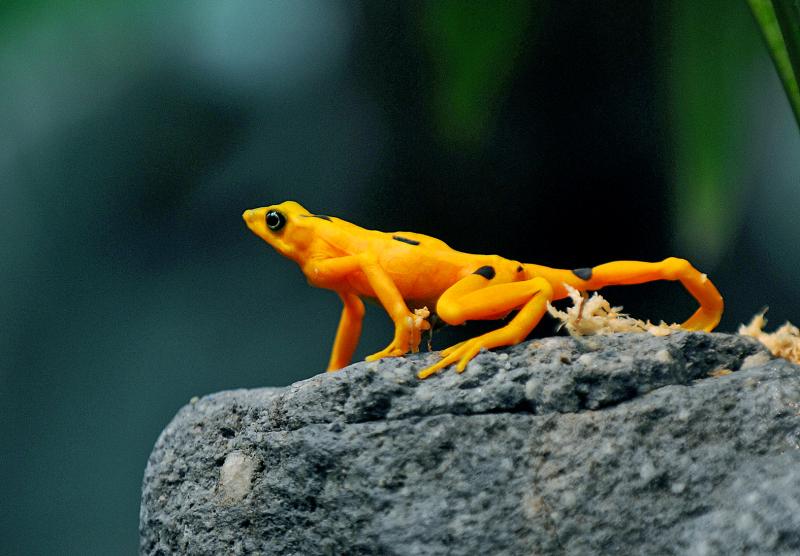Cocooned from the outside world, about 200 critically endangered golden frogs are living a sheltered existence in Panama, protected from a devastating fungus that threatens to wipe out one-third of the country’s amphibian species — a situation scientists describe as “critical.”
The frogs, which are yellow or gold with black spots, enjoy a controlled environment inside fish tanks installed at the Smithsonian Tropical Research Institute (STRI), a 465m2 facility in Gamboa, north of Panama City.
Although endemic to the lush Central American country, no Panamanian golden frog can be seen in its natural habitat, threatened as it is by a so-called “superfungus” that has decimated amphibians in the wild.

Photo: AFP
According to a report by the WWF published last week, the planet has lost more than two-thirds of its vertebrates in less than 50 years.
The situation is especially dire in the tropical areas of Central and South America, where the extent of loss is pegged at 94 percent.
Believed extinct in the wild, only about 1,500 of the tiny Panamanian golden frogs are found in zoos where they can reproduce.
However, it is not only frogs that are vulnerable to the fungus. Toads, salamanders and caecilians — limbless amphibians similar to snakes — are also at risk.
“In Panama, we can say that about a third of the 225 species of amphibians are threatened in some way,” STRI researcher Roberto Ibanez said.
Gina Della Togna, a specialist in molecular and cellular biology at the University of Maryland, described the situation as “critical.”
The biggest threat posed to amphibians is chytrid fungus, which spreads through water.
The pathogen is responsible for chytridiomycosis, an infectious disease that scientists say has already caused the disappearance of about 30 species.
The fungus becomes embedded in the animal’s skin and infects it, causing it to be unable to exchange salts and water with the environment.
The disease causes irreparable damage to vital functions. Eventually the animal dies of heart failure caused by asphyxiation.
“It’s a pretty dramatic and painful disease,” said Angie Estrada, a biologist at Virginia Tech University and administrator of Panama’s Summit Park. “When the fungus gets to a place where it wasn’t, it affects populations very much and animals die en masse. It causes certain death in the individuals it infects. It’s a devastating phenomenon,” Della Togna said.
The microorganism was first detected in the 20th century in the Korean Peninsula and scientists have said that it has already spread throughout the world.
“Anywhere in the world where there are amphibians, the fungus is already there,” Estrada said.
It arrived in Panama in the early 1990s and has been wreaking havoc ever since.
“It’s a superfungus that can even affect other species that are not amphibians,” Ibanez said.
He warned that deforestation, environmental destruction and pollution of streams and rivers caused by humans exacerbate the problem.
Despite the gloomy scenario, scientists point to some glimmers of hope, saying that in the past few years some species believed to have gone extinct have been rediscovered.
Specialists suspect that some amphibians have been able to bolster their defenses against infection.
“This gives us hope, knowing that some frogs are returning and that they have ways to counterattack” the fungus, Estrada said.
In Gamboa, the STRI maintains about 2,000 specimens from 12 frog species in the hope they can one day be released into the wild to fend for themselves.
“The idea is not to keep these animals in captivity forever. We want to be able to re-establish populations in their natural habitat,” Ibanez said.
To that end, Smithsonian researcher Della Togna is carrying out an assisted reproduction project, where she freezes the animals’ semen to impregnate the females and increase their numbers.
With great care, she injected hormones into the tiny frogs that appear to get lost in the palm of her hand.
“Of all the different animals, amphibians are the world’s most threatened,” Della Togna said.

Swedish campaigner Greta Thunberg was deported from Israel yesterday, the Israeli Ministry of Foreign Affairs said, the day after the Israeli navy prevented her and a group of fellow pro-Palestinian activists from sailing to Gaza. Thunberg, 22, was put on a flight to France, the ministry said, adding that she would travel on to Sweden from there. Three other people who had been aboard the charity vessel also agreed to immediate repatriation. Eight other crew members are contesting their deportation order, Israeli rights group Adalah, which advised them, said in a statement. They are being held at a detention center ahead of a

A Chinese scientist was arrested while arriving in the US at Detroit airport, the second case in days involving the alleged smuggling of biological material, authorities said on Monday. The scientist is accused of shipping biological material months ago to staff at a laboratory at the University of Michigan. The FBI, in a court filing, described it as material related to certain worms and requires a government permit. “The guidelines for importing biological materials into the US for research purposes are stringent, but clear, and actions like this undermine the legitimate work of other visiting scholars,” said John Nowak, who leads field

Former Nicaraguan president Violeta Chamorro, who brought peace to Nicaragua after years of war and was the first woman elected president in the Americas, died on Saturday at the age of 95, her family said. Chamorro, who ruled the poor Central American country from 1990 to 1997, “died in peace, surrounded by the affection and love of her children,” said a statement issued by her four children. As president, Chamorro ended a civil war that had raged for much of the 1980s as US-backed rebels known as the “Contras” fought the leftist Sandinista government. That conflict made Nicaragua one of

NUCLEAR WARNING: Elites are carelessly fomenting fear and tensions between nuclear powers, perhaps because they have access to shelters, Tulsi Gabbard said After a trip to Hiroshima, US Director of National Intelligence Tulsi Gabbard on Tuesday warned that “warmongers” were pushing the world to the brink of nuclear war. Gabbard did not specify her concerns. Gabbard posted on social media a video of grisly footage from the world’s first nuclear attack and of her staring reflectively at the Hiroshima Peace Memorial. On Aug. 6, 1945, the US obliterated Hiroshima, killing 140,000 people in the explosion and by the end of the year from the uranium bomb’s effects. Three days later, a US plane dropped a plutonium bomb on Nagasaki, leaving abut 74,000 people dead by the